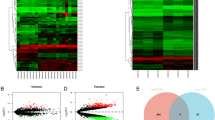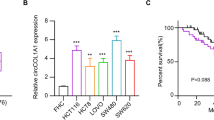Abstract
Background
Hepatocellular carcinoma (HCC) is a primary liver cancer with a high mortality rate. It has been reported that circular RNA hsa_circ_0091579 (circ_0091579) is involved in HCC progression. Nevertheless, the molecular mechanism by which circ_0091579 modulates HCC advancement is indistinct.
Methods
The expression of circ_0091579, microRNA (miR)-624, and H3 histone family member 3B (H3F3B) mRNA was evaluated by quantitative real-time polymerase chain reaction (qRT-PCR). The extracellular acidification rate (ECAR) and oxygen consumption rate (OCR) of HCC cells were analyzed using an extracellular flux analyzer. Adenosine triphosphate (ATP) level was evaluated using a commercial kit. Cell migration, invasion, and apoptosis were assessed by wound-healing, transwell, or flow cytometry assay. The relationship between miR-624 and circ_0091579 or H3F3B was verified using luciferase reporter assay and/or RNA immunoprecipitation (RIP) assay. H3F3B protein level was detected by western blotting.
Results
Circ_0091579 was upregulated in HCC tissues and cells. Circ_0091579 inhibition decreased xenograft tumor growth in vivo and repressed Warburg effect, migration, invasion, and induced apoptosis of HCC cells in vitro. MiR-624 was downregulated, while H3F3B was upregulated in HCC tissues and cells. Circ_0091579 acted as a miR-624 sponge and regulated H3F3B expression by adsorbing miR-624. MiR-624 inhibitor reversed circ_0091579 downregulation-mediated effects on the Warburg effect and malignant behaviors of HCC cells. H3F3B overexpression reversed the repressive impact of miR-624 mimic on the Warburg effect and malignancy of HCC cells.
Conclusions
Circ_0091579 accelerated Warburg effect and tumor growth via upregulating H3F3B via adsorbing miR-624 in HCC, providing evidence to support the involvement of circ_0091579 in the progression of HCC.








Similar content being viewed by others
References
Bray F, Ferlay J, Soerjomataram I, Siegel RL, Torre LA, Jemal A. Global cancer statistics 2018: GLOBOCAN estimates of incidence and mortality worldwide for 36 cancers in 185 countries. CA Cancer J Clin. 2018;68(6):394–424.
Raza A, Sood GK. Hepatocellular carcinoma review: current treatment, and evidence-based medicine. World J Gastroenterol. 2014;20(15):4115–27.
Hartke J, Johnson M, Ghabril M. The diagnosis and treatment of hepatocellular carcinoma. Semin Diagn Pathol. 2017;34(2):153–9.
Yeh JJ, Uemura M. Hepatocellular carcinoma, N Engl J Med 2012;366(1):92; author reply 92–92; author reply 93.
Llovet JM, Montal R, Sia D, Finn RS. Molecular therapies and precision medicine for hepatocellular carcinoma. Nat Rev Clin Oncol. 2018;15(10):599–616.
Qu S, Yang X, Li X, Wang J, Gao Y, Shang R, Sun W, Dou K, Li H. Circular RNA: A new star of noncoding RNAs. Cancer Lett. 2015;365(2):141–8.
Song H, Liu Q, Liao Q. Circular RNA and tumor microenvironment. Cancer Cell Int. 2020;20:211.
Tang Q, Hann SS. Biological roles and mechanisms of circular RNA in human cancers. Onco Targets Ther. 2020;13:2067–92.
Liu G, Zhou J, Piao Y, Zhao X, Zuo Y, Ji Z. Hsa_circ_0085576 promotes clear cell renal cell carcinoma tumorigenesis and metastasis through the miR-498/YAP1 axis. Aging (Albany NY) 2020;12.
Chen C, Yin P, Hu S, Sun X, Li B. Circular RNA-9119 protects IL-1β-treated chondrocytes from apoptosis in an osteoarthritis cell model by intercepting the microRNA-26a/PTEN axis. Life Sci. 2020;117924.
Zhang C, Zhang C, Lin J, Wang H. Circular RNA Hsa_Circ_0091579 serves as a diagnostic and prognostic marker for hepatocellular carcinoma. Cell Physiol Biochem. 2018;51(1):290–300.
Niu WY, Chen L, Zhang P, Zang H, Zhu B, Shao WB. Circ_0091579 promotes proliferative ability and metastasis of liver cancer cells by regulating microRNA-490-3p. Eur Rev Med Pharmacol Sci. 2019;23(23):10264–73.
Hansen TB, Jensen TI, Clausen BH, Bramsen JB, Finsen B, Damgaard CK, Kjems J. Natural RNA circles function as efficient microRNA sponges. Nature. 2013;495(7441):384–8.
Peng X, Wei F, Hu X. Long noncoding RNA DLGAP1-AS1 promotes cell proliferation in hepatocellular carcinoma via sequestering miR-486-5p. J Cell Biochem. 2020;121(2):1953–62.
Lu J, Tan M, Cai Q. The Warburg effect in tumor progression: mitochondrial oxidative metabolism as an anti-metastasis mechanism. Cancer Lett. 2015;356(2 Pt A):156–64.
Vaupel P, Schmidberger H, Mayer A. The Warburg effect: essential part of metabolic reprogramming and central contributor to cancer progression. Int J Radiat Biol. 2019;95(7):912–9.
Wang S, Zhang Y, Cai Q, Ma M, Jin LY, Weng M, Zhou D, Tang Z, Wang JD, Quan Z. Circular RNA FOXP1 promotes tumor progression and Warburg effect in gallbladder cancer by regulating PKLR expression. Mol Cancer. 2019;18(1):145.
Cao L, Wang M, Dong Y, Xu B, Chen J, Ding Y, Qiu S, Li L, Zaharieva EK, Zhou X, Xu Y. Circular RNA circRNF20 promotes breast cancer tumorigenesis and Warburg effect through miR-487a/HIF-1α/HK2. Cell Death Dis. 2020;11(2):145.
Van Roosbroeck K, Calin GA. Cancer hallmarks and microRNAs: the therapeutic connection. Adv Cancer Res. 2017;135:119–49.
Panda AC. Circular RNAs act as miRNA sponges. Adv Exp Med Biol. 2018;1087:67–79.
Zhang Y, Liu H, Li W, Yu J, Li J, Shen Z, Ye G, Qi X, Li G. CircRNA_100269 is downregulated in gastric cancer and suppresses tumor cell growth by targeting miR-630. Aging (Albany NY). 2017;9(6):1585–94.
Sang Y, Chen B, Song X, Li Y, Liang Y, Han D, Zhang N, Zhang H, Liu Y, Chen T, Li C, Wang L, Zhao W, Yang Q. circRNA_0025202 regulates tamoxifen sensitivity and tumor progression via regulating the miR-182-5p/FOXO3a axis in breast cancer. Mol Ther. 2019;27(9):1638–52.
Lin C-Y, Wang S-W, Chen Y-L, Chou W-Y, Lin T-Y, Chen W-C, Yang C-Y, Liu S-C, Hsieh C-C, Fong Y-C, Wang P-C, Tang C-H. Brain-derived neurotrophic factor promotes VEGF-C-dependent lymphangiogenesis by suppressing miR-624-3p in human chondrosarcoma cells. Cell Death Dis. 2017;8(8):e2964.
He Y, Mingyan E, Wang C, Liu G, Shi M, Liu S. CircVRK1 regulates tumor progression and radio resistance in esophageal squamous cell carcinoma by regulating miR-624-3p/PTEN/PI3K/AKT signaling pathway. Int J Biol Macromol. 2019;125:116–23.
Luo Y, Liu W, Tang P, Jiang D, Gu C, Huang Y, Gong F, Rong Y, Qian D, Chen J, Zhou Z, Zhao S, Wang J, Xu T, Wei Y, Yin G, Fan J, Cai W. miR-624-5p promoted tumorigenesis and metastasis by suppressing hippo signaling through targeting PTPRB in osteosarcoma cells. J Exp Clin Cancer Res. 2019;38(1):488.
Duan R, Li C, Wang F, Han F, Zhu L. The Long noncoding RNA ZFAS1 potentiates the development of hepatocellular carcinoma via the microRNA-624/MDK/ERK/JNK/P38 signaling pathway. Onco Targets Ther. 2020;13:4431–44.
Saliminejad K, Khorshid HRK, Fard SS, Ghaffari SH. An overview of microRNAs: biology, functions, therapeutics, and analysis methods. J Cell Physiol. 2019;234(5):5451–65.
Presneau N, Shen Z, Provencher D, Mes-Masson A-M, Tonin PN. Identification of novel variant, 1484delG in the 3’UTR of H3F3B, a member of the histone 3B replacement family, in ovarian tumors. Int J Oncol. 2005;26(6):1621–7.
Schaefer I-M, Fletcher JA, Nielsen GP, Shih AR, Ferrone ML, Hornick JL, Qian X. Immunohistochemistry for histone H3G34W and H3K36M is highly specific for giant cell tumor of bone and chondroblastoma, respectively, in FNA and core needle biopsy. Cancer Cytopathol. 2018;126(8):552–66.
Ayoubi HA, Mahjoubi F, Mirzaei R. Investigation of the human gene expression as a novel marker in patients with colorectal cancer. J Gastrointest Oncol. 2017;8(1):64–9.
Author information
Authors and Affiliations
Corresponding author
Ethics declarations
Conflict of interest
The authors declare that they have no financial conflicts of interest.
Additional information
Publisher's Note
Springer Nature remains neutral with regard to jurisdictional claims in published maps and institutional affiliations.
Supplementary Information
Below is the link to the electronic supplementary material.
Rights and permissions
About this article
Cite this article
Chen, Y., Song, S., Zhang, L. et al. Circular RNA hsa_circ_0091579 facilitates the Warburg effect and malignancy of hepatocellular carcinoma cells via the miR-624/H3F3B axis. Clin Transl Oncol 23, 2280–2292 (2021). https://doi.org/10.1007/s12094-021-02627-4
Received:
Accepted:
Published:
Issue Date:
DOI: https://doi.org/10.1007/s12094-021-02627-4




